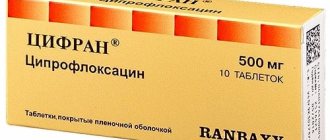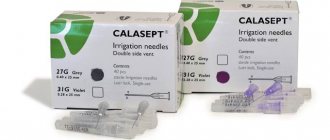Throughout his life, a person often encounters the negative effects of microbes on the body. Bacterial pathogens can settle on the skin, in the gastrointestinal tract, in the genitourinary organs and even on the conjunctiva of the eye. In such a situation, only a strong antibacterial agent will help cope with the infection. Most often, treatment begins with medications based on ciprofloxacin, so doctors often prescribe the antibiotic Tsiprolet to patients. Next we will talk about the beneficial properties of this medication.
Release form
Tsiprolet is produced by many pharmaceutical companies, as it is one of the most popular antibacterial agents. It is produced in the following dosage forms:
- infusion solution - in polyethylene bottles of 100 ml, where the content of ciprofloxacin does not exceed 2 mg per ml;
- tablets - each containing 250 mg or 500 mg of the main active ingredient, they are packaged in blisters of 10 pieces;
- eye drops - sold in bottles with a dropper of 5-10 ml, which contain 3 mg of ciprofloxacin per 1 ml of solution.
According to the instructions for use of Tsiprolet 500, these tablets contain the maximum dose of the active substance. They are used to treat severe bacterial lesions in advanced infections.
Comparison of ease of use of Tsiprolet A and Tsiprolet
This includes dose selection taking into account various conditions and frequency of doses. At the same time, it is important not to forget about the release form of the drug; it is also important to take it into account when making an assessment.
The ease of use of Tsiprolet A is approximately the same as Tsiprolet. However, they are not convenient enough to use.
The drug ratings were compiled by experienced pharmacists who studied international research. The report is generated automatically.
Last update date: 2020-12-04 13:48:25
Mechanism of action of the drug
Tsiprolet belongs to the group of fluoroquinolones and is an antibacterial drug with a wide range of effects. Its main active ingredient is ciprofloxacin. This chemical compound has the ability to penetrate the DNA structure of the cells that cause the infection, thereby disrupting the vital functions of bacteria, their ability to subsequently reproduce and develop. The result of this influence is the death of harmful microorganisms.
Tsiprolet tablets have a complex effect, effectively destroying microbes that are both at the reproduction stage and in the resting phase. The spectrum of negative effects of this medicine extends to almost all types of gram-positive and gram-negative bacteria, most of the anaerobic pathogens. The instructions for use of Tsiprolet state that its main active component actively eliminates bacterial microflora that are resistant to other antibiotics, for example, the nitrofuran or sulfonamide series. Resistance of microbes to this medicine appears only after a long period of time.
Tsiprolet
A broad-spectrum antibacterial drug from the group of fluoroquinolones. Acts bactericidal. The drug inhibits the enzyme DNA gyrase of bacteria, as a result of which DNA replication and the synthesis of cellular proteins of bacteria are disrupted. Ciprofloxacin acts both on microorganisms that are reproducing and those in the resting phase.
Gram-negative aerobic bacteria are sensitive to ciprofloxacin: Escherichia coli, Salmonella spp., Shigella spp., Citrobacter spp., Klebsiella spp., Enterobacter spp., Proteus mirabilis, Proteus vulgaris, Serratia marcescens, Hafhia alvei, Edwardsiella tarda, Providencia spp., Morganella morganii, Vibrio spp., Yersinia spp.; other gram-negative bacteria: Haemophilus spp., Pseudomonas aeruginosa, Moraxella catarrhalis, Aeromonas spp., Pasteurella multocida, Plesiomonas shigelloides, Campylobacter jejuni, Neisseria spp.; some intracellular pathogens: Legionella pneumophila, Brucella spp., Chlamydia trachomatis, Listeria monocytogenes, Mycobacterium tuberculosis, Mycobacterium kansasii, Mycobacterium avium-intracellulare.
Gram-positive aerobic bacteria are also sensitive to ciprofloxacin: Staphylococcus spp. (S.aureus, S.haemolyticus, S.hominis, S.saprophyticus), Streptococcus spp. (St. pyogenes, St. agalactiae). Most staphylococci resistant to methicillin are also resistant to ciprofloxacin.
The sensitivity of bacteria Streptococcus pneumoniae and Enterococcus faecalis is moderate.
Corynebacterium spp., Bacteroides fragilis, Pseudomonas cepacia, Pseudomonas maltophilia, Ureaplasma urealyticum, Clostridium difficile, Nocardia asteroides are resistant to the drug. The effect of the drug against Treponema pallidum has not been sufficiently studied.
Pharmacokinetics
When taken orally, ciprofloxacin is rapidly absorbed from the gastrointestinal tract. The bioavailability of the drug is 50-85%. Cmax of the drug in the blood serum of healthy volunteers after oral administration of the drug (before meals) at a dose of 250, 500, 750 and 1000 mg is achieved after 1-1.5 hours and is 1.2, 2.4, 4.3 and 5.4 μg/ml, respectively.
Orally taken ciprofloxacin is distributed in the tissues and fluids of the body. High concentrations of the drug are observed in bile, lungs, kidneys, liver, gall bladder, uterus, seminal fluid, prostate tissue, tonsils, endometrium, fallopian tubes and ovaries. The concentration of the drug in these tissues is higher than in the serum. Ciprofloxacin also penetrates well into bones, eye fluid, bronchial secretions, saliva, skin, muscles, pleura, peritoneum, and lymph.
The accumulating concentration of ciprofloxacin in blood neutrophils is 2-7 times higher than in serum.
Vd in the body is 2-3.5 l/kg. The drug penetrates into the cerebrospinal fluid in a small amount, where its concentration is 6-10% of that in the serum.
The degree of binding of ciprofloxacin to plasma proteins is 30%.
In patients with unchanged renal function, T1/2 is usually 3-5 hours. The main route of excretion of ciprofloxacin from the body is through the kidneys. 50-70% is excreted in urine. From 15 to 30% is excreted in feces.
If renal function is impaired, T1/2 increases.
Patients with severe renal failure (creatinine clearance below 20 ml/min/1.73 m2) should be prescribed half the daily dose of the drug.
Indications
Ciprofan tablets - what do they help with? This antibiotic is used for the treatment of complicated or uncomplicated bacterial infections that are caused by strains of microorganisms sensitive to ciprofloxacin. The remedy is indicated for the following diseases:
- urinary tract infections;
- bacterial lesions of the gastrointestinal tract;
- sepsis;
- pathologies of ENT organs, especially in case of infection with staphylococcal microflora and gram-negative bacteria, including the Pseudomonas type;
- peritonitis;
- infectious lesions of the respiratory system (for example, pneumonia), if they are caused by Enterobacter, Staphylococcus, Klebsiella, Haemophilus influenzae, Legionella or microbes of the Branhamella, Pseudomonas species;
- inflammatory infectious diseases of the genital organs in men and women (prostatitis, adnexitis);
- infections of the musculoskeletal system and skin;
- some sexually transmitted diseases (gonorrhea);
- bacterial lesions of the eyelid and conjunctiva of the eyes;
- therapy and prevention of infections in patients with low immunity (for example, with neutropenia or after treatment with immunosuppressive drugs).
Comparison of addiction between Tsiprolet A and Tsiprolet
Like safety, addiction also involves many factors that must be considered when evaluating a drug.
So, the totality of the values of such parameters as “syndrome o” in Tsiprolet A is quite similar to the similar values in Tsiprolet. Withdrawal syndrome is a pathological condition that occurs after the cessation of intake of addictive or dependent substances into the body. And resistance is understood as initial immunity to a drug; in this it differs from addiction, when immunity to a drug develops over a certain period of time. The presence of resistance can only be stated if an attempt has been made to increase the dose of the drug to the maximum possible. At the same time, in Tsiprolet A the values of “syndrome o” are quite small, however, the same as in Tsiprolet.
Dosage and methods of application
The antibiotic Tsiprolet is prescribed by a doctor after examining the patient. The dose of the drug is selected based on the type of infection, the severity of the disease and the patient’s condition. The dosage regimen is also influenced by the functional ability of the urinary organs and the person’s body weight (when used in adolescence and childhood).
For the most severe cases of infection and when it is impossible to take the medication in tablet form, Tsiprolet is prescribed in the form of infusion solutions. Then the intravenous infusions of the drug are gradually stopped, and the patient switches to internal administration of the medication. The tablets do not need to be chewed; they simply need to be swallowed whole and washed down with a small amount of water. Take Tsiprolet, regardless of food intake, 500-750 mg twice a day.
The duration of therapy depends on the severity of the pathology and can vary from 3 to 21 days. Usually the doctor prescribes the use of this antibiotic for a period of 7 to 14 days.
Comparison of safety of Tsiprolet A and Tsiprolet
The safety of a drug includes many factors.
At the same time, in Tsiprolet A it is quite similar to Tsiprolet. It is important where the drug is metabolized: drugs are excreted from the body either unchanged or in the form of products of their biochemical transformations. Metabolism occurs spontaneously, but most often involves major organs such as the liver, kidneys, lungs, skin, brain and others. When assessing the metabolism of Tsiprolet A, as well as Tsiprolet, we look at which organ is the metabolizing organ and how critical the effect on it is.
The risk-benefit ratio is when the prescription of a drug is undesirable, but justified under certain conditions and circumstances, with the obligatory observance of caution in use. At the same time, Tsiprolet A does not have any risks when used, just like Tsiprolet.
Also, when calculating safety, it is taken into account whether only allergic reactions occur or possible dysfunction of the main organs. In other matters, as well as the reversibility of the consequences of using Tsiprolet A and Tsiprolet.
Adverse reactions and contraindications for use
Tsiprolet very rarely causes allergic reactions. After treatment with this medication, the following side effects most often develop: dyspeptic disorders, nausea and vomiting, skin itching and rash, shortness of breath.
The use of this medicine is contraindicated in the following cases:
- during pregnancy;
- if you are allergic to ciprofloxacin and quinolone drugs;
- in adolescence and childhood;
- during lactation.
Tsiprolet is prescribed with caution to elderly patients. The medication is used only in special cases for people suffering from epilepsy, vascular pathologies, and organic diseases of the brain. Such patients are more likely to experience side effects due to taking the drug, so this antibiotic is indicated for them only in life-threatening situations. In case of allergic reactions and other complaints (for example, joint pain, myalgia), use of the medicine should be discontinued.
Special information
Tsiprolet is not effective against streptococci, so it is not prescribed for the treatment of pathologies caused by bacteria of this group. In case of severe infection by anaerobes and staphylococcal microflora, it is better to take the medication in combination with other antibiotics, which will help enhance the therapeutic effect of ciprofloxacin.
The instructions for Tsiprolet tablets indicate that this drug can have an effect on the patient’s body, changing the ability to concentrate. Therefore, it should not be used by transport drivers and persons servicing complex mechanisms and machines. It is unacceptable to use the medication in combination with alcohol. Tsiprolet is available only with a doctor's prescription.
Comparison of the effectiveness of Tsiprolet A and Tsiprolet
Tsiprolet A is more effective than Tsiprolet - this means that the ability of the medicinal substance to provide the maximum possible effect is different.
For example, if the therapeutic effect of Tsiprolet A is more pronounced, then it is impossible to achieve this effect with Tsiprolet even in large doses.
Also, the speed of therapy is an indicator of the speed of the therapeutic action; Tsiprolet A and Tsiprolet are also different, as is bioavailability - the amount of a medicinal substance reaching the place of its action in the body. The higher the bioavailability, the less it will be lost during absorption and use by the body.









